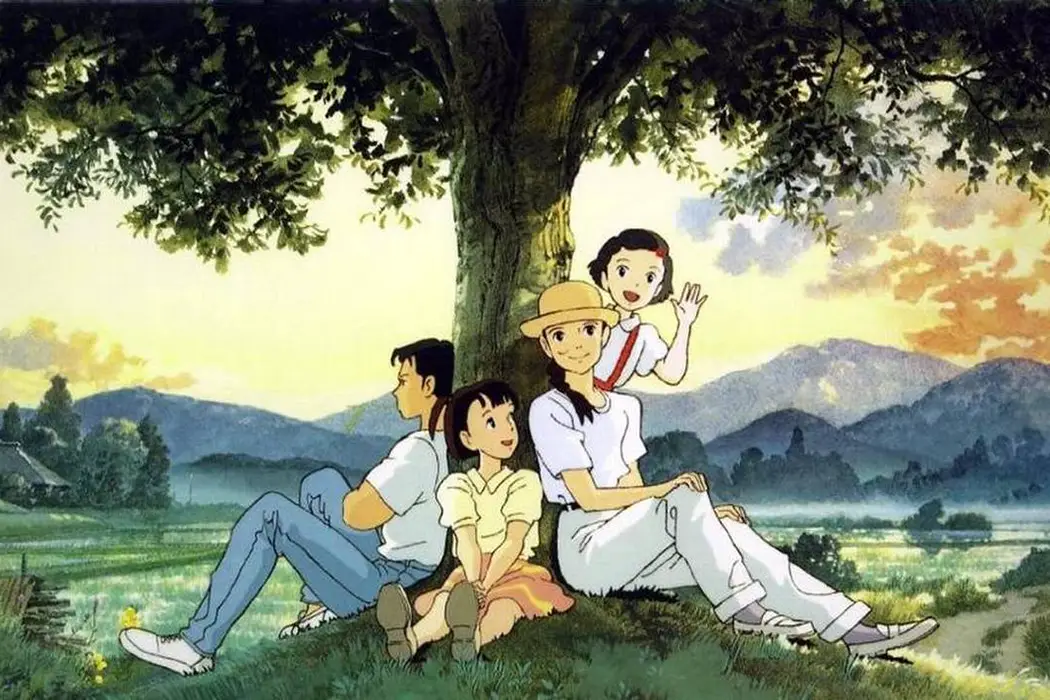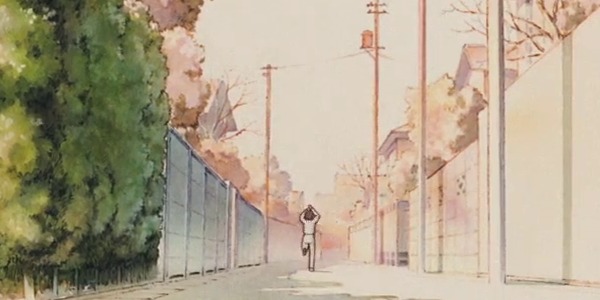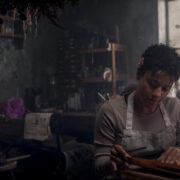ONLY YESTERDAY: Unfolding In The Countryside

Ben is a former student of cognitive science who is…
The first time I saw Only Yesterday, it went over my head. I tried to separate it into component parts – such is the inclination with a lot of film criticism – and rearrange them. It does, at first glance, appear to present itself in disparate pieces. It shifts back and forth between the main character Naoko’s present life as a 27-year-old and flashbacks to her life as a 10-year old. The flashback sequences are characterized by noticeable stylistic differences from scenes meant to take place in the present, and sometimes fantasy will intrude on and subsume reality. Even the music is eclectic, with Hungarian folk music and a Japanese cover of an American song accompanying its original score.
In one part of the film, the 10-year-old Naoko takes flight and soars home through a sea of pink clouds; in another, the film offers a down-to-earth and strangely in-depth explanation of the process of safflower harvesting when the adult Naoko goes to visit her relatives in the country. There must, I had thought, be some contradiction between these scenes; but now I don’t think the contrast between these things matters so much as how they bear on Naoko’s relationship to the world around her. They embody similar feelings, but in different contexts and at different times.
Only Yesterday begins as an ode to nature with an appreciation for country lifestyles, but through brilliant strokes like this, it reveals itself instead as a film that captures a process of self-realization. Eventually we find that Only Yesterday takes on a kind of individualism based on love and ever-increasing interaction with one’s surroundings. Little conflicts may pop up here and there, but the story isn’t dominated by any of them; it’s driven by movement that encompasses a much larger range of experiences.
The King of Fruits
For those who have seen Only Yesterday, one of its most memorable scenes is one in which the 10-year-old Naoko sits down with her family to eat a pineapple, a food none of them has tasted before. It’s memorable because it’s funny; not because it’s structured as a joke, but because it takes on a perspective broad enough to show humor unfolding naturally from a more-or-less familiar situation.
Part of the reason it’s able to do this is its attention to detail. In something as simple and brief as the occasion of sitting down to eat, the blocking, the characters’ body language, and very subtle changes in the composition express a wide array of ideas and emotions regarding the relationships between the members of Naoko’s family. Other scenes attain similar effects through the use of angular or curved lines, in a way similar to that seen in Chie the Brat and The Tale of the Princess Kaguya, other films by Isao Takahata in which family ties and other social pressures complicate the characters’ lives.

None of these pressures are stable or strictly defined in Only Yesterday; they change continually, both in Naoko’s own life, and in the culture at large over the years between Naoko’s childhood and her adulthood. We see her sisters balance their own shifting interests with those of their whole family unit, and the young Naoko’s not-as-successful attempts to do the same.
Roads, Rainbows, and Flowers
All this is to say that the characters in Only Yesterday have individuality and autonomy, but are also each only part of a whole – a whole that might be a family, a class, a workplace, or a community of farmers. Likewise, the fantasy, rigorously-detailed realism, and different timelines contrast with each other, but also cohere seamlessly: the film eases into flashbacks in brief sequences of past and present overlapping, and fantasy never imposes on apparent reality so much as emerges from it as if it were completely natural.
Take, for instance, one scene in which the young Naoko impassively walks home from school, surrounded by the sharp angles of intersecting fences along residential blocks. After sharing a slightly awkward but sweet exchange with another student she encounters on her way, her mood improves; she starts to run home, and begins rising into the air, propelled above the grid of roads and houses.
The impetus of Only Yesterday is the meeting between the uniqueness of its parts and the necessity of the whole. Everything overlaps and boundaries are loosely defined, but when all is right with the world, individuality still comes through in a constant production of novelty. We never see Naoko not embedded in a community, but some of them allow for this more than others.

This is where Only Yesterday pulls one over on you: it originally comes across as a celebration of nature in a general sense of the word referring to life in a rural community; but in the end, it’s more a celebration of Naoko’s own nature which is able to flourish in that community.
To Conclude
The two times I’ve shared Only Yesterday with an audience, it functioned best as a comedy. Its sense of humor is muted, but rich, and if you approach it with that in mind, you probably won’t be disappointed. The country landscapes also carry a lot of casual beauty, and the way it has things run together comes with its own wonder.
Only Yesterday nearly equals The Tale of the Princess Kaguya among the films that mean most to me, and while I slightly prefer the latter, the former may be Isao Takahata‘s most subtle and cleverly structured film. Compared to some of Studio Ghibli’s most internationally well-known films, Only Yesterday might be the kind of film that needs to find its audience; even so, I have no compunctions about saying it’s easily among their very best work.
What films, if any, necessitated a shift in your perspective?
Only Yesterday was released in 1991. It is currently available for home viewing on Blu-ray from Gkids.
https://youtu.be/x0ZrjocXVJ4
Does content like this matter to you?
Become a Member and support film journalism. Unlock access to all of Film Inquiry`s great articles. Join a community of like-minded readers who are passionate about cinema - get access to our private members Network, give back to independent filmmakers, and more.
Ben is a former student of cognitive science who is currently trying to improve his writing style and ability to understand and appreciate films containing unfamiliar perspectives. He tries not to hold films to a strict set of criteria, but does believe that strong movies can change your outlook on the world. His favorite films include Whisper of the Heart, Hellzapoppin', Foolish Wives, 42nd Street, and the work of Charlie Chaplin.













